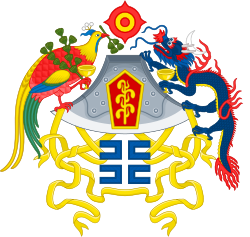Fenghuang
Fenghuang (Chinese: 鳳凰; Pinyin: Fènghuáng; is the name of two Chinese mythological birds, that were central figures in ancient Chinese cosmology. Sometimes called the Chinese Phoenix, the Fenghuang is a symbol of summer and spiritual balance, and along with the dragon, qilin and tortoise, is one of the most highly revered creatures in Chinese tradition. Its appearance is said to indicate some great event, or to bear testimony to the greatness of a ruler.
Fenghuang Media
Image of the fenghuang opposite the dragon on the Twelve Symbols national emblem, which was the state emblem of China from 1913 to 1928
Jade phoenix, unearthed from the tomb of Fu Hao, c. 1200 BC, Shang dynasty.
A phoenix (top) and dragon (left), Silk Painting of a Human Figure with Phoenix and Dragon, Silk painting unearthed from a Chu tomb.
Man playing sheng to a phoenix, Dengzhou painted stone-relief, Liu Song dynasty.
Basin with dragon and phoenix design, Jingdezhen ware, China, Ming dynasty, Wanli era, 1573-1620 AD. Tokyo National Museum
A fenghuang on the roof of Longshan Temple in Taipei
Drawing of a Fum Hoam (fenghuang) by a Dutch man, circa 1664.
Classic of Mountains and Seas illustration of a nine-headed phoenix (colored Qing Dynasty edition)










